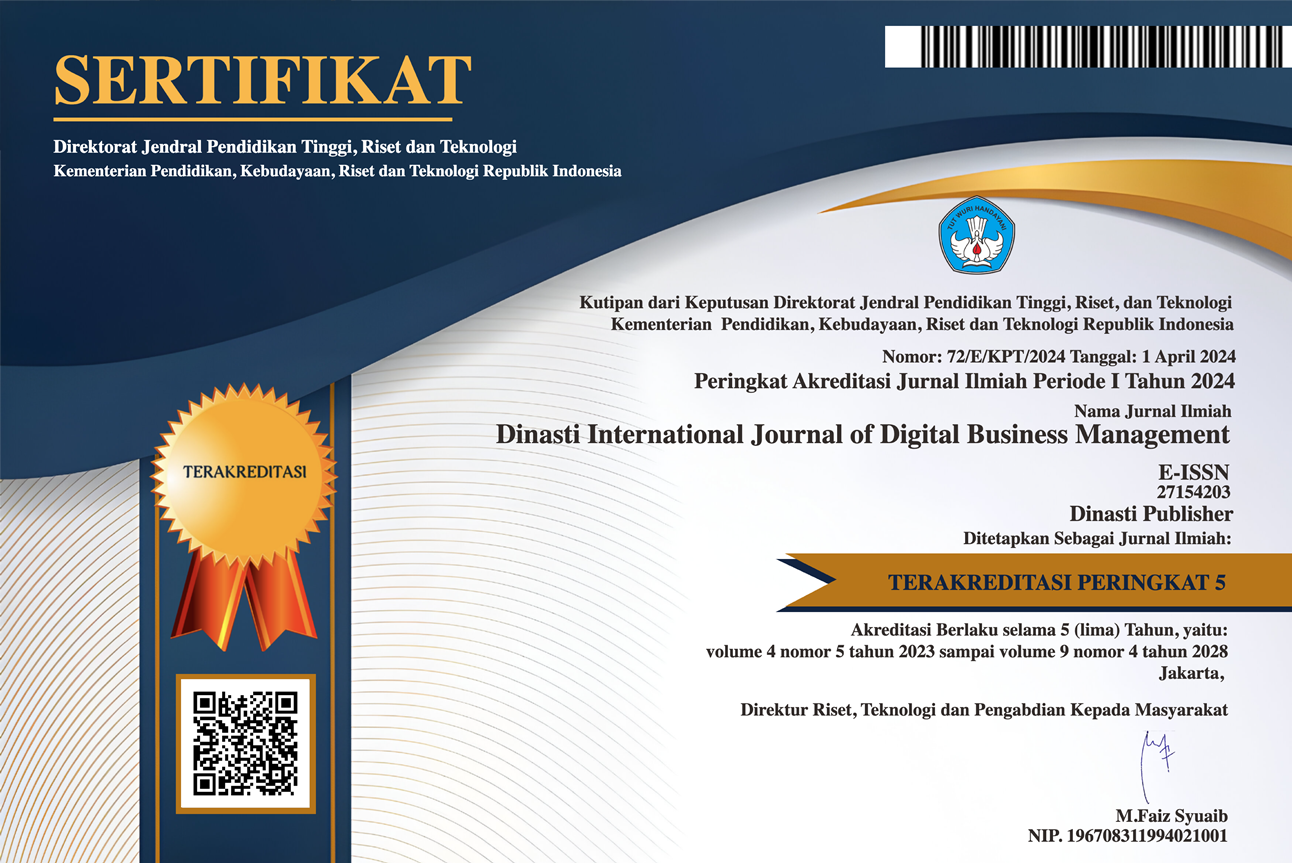Implementation Student Learning Achievement for Student: Literature Review
DOI:
https://doi.org/10.31933/dijdbm.v5i2.2237Keywords:
Intrinsic Factors, Motivation, Student Learning AchievementAbstract
The purpose of this article is to investigate and describe the role of intrinsic factors and motivation in student learning achievement and explain how students' internal characteristics (intrinsic factors) and drive to learn (motivation) are interrelated and how these interactions affect their learning outcomes with a literature review. This article uses qualitative methods with a literature review for the implementation of Intrinsic Factors, Motivation, and Intrinsic Factors, Motivation, Student Learning Achievement. Innate and motivational factors play a fundamental role in the realm of education, shaping the path of student learning achievement. Identifying and leveraging these factors can enhance the learning journey, allowing students to maximize their academic capabilities. The complex interaction between intrinsic factors and motivation serves as the basis of student achievement. Acknowledging and fostering students' internal attributes, coupled with creating a motivating environment according to their unique needs, is essential to unlocking their full academic potential. The recommendations given in this article are in the form of views that are expected to create an educational environment that supports students' development holistically, motivates them to learn, and helps them reach their full academic potential.
References
Akhtar, S. N., Iqbal, M., & Tatlah, I. A. (2017). Relationship between Intrinsic Motivation and Students’ Academic Achievement: A Secondary Level Evidence. Bulletin of Education and Research, 39(2), 19–29.
Almulla, M. A., & Alamri, M. M. (2021). Using conceptual mapping for learning to affect students’ motivation and academic achievement. Sustainability, 13(7), 4029.
Bai, B., & Wang, J. (2023). The role of growth mindset, self-efficacy and intrinsic value in self-regulated learning and English language learning achievements. Language Teaching Research, 27(1), 207–228.
Baygi, A. H., Ghonsooly, B., & Ghanizadeh, A. (2017). Self-Fulfillment in Higher Education: Contributions from Mastery Goal, Intrinsic Motivation, and Assertions. The Asia-Pacific Education Researcher, 26, 171–182. https://api.semanticscholar.org/CorpusID:55921740
Burns, E. C., Martin, A. J., & Collie, R. J. (2019). Examining the yields of growth feedback from science teachers and students’ intrinsic valuing of science: Implications for student?and school?level science achievement. Journal of Research in Science Teaching, 56(8), 1060–1082.
Chan, Y. L., & Norlizah, C. H. (2017). Students’ motivation towards science learning and students’ science achievement. International Journal of Academic Research in Progressive Education and Development, 6(4), 174–189.
Chiu, T. K. F., Moorhouse, B. L., Chai, C. S., & Ismailov, M. (2023). Teacher support and student motivation to learn with Artificial Intelligence (AI) based chatbot. Interactive Learning Environments. https://api.semanticscholar.org/CorpusID:256679403
Fanani, I. Y., Prakoso, R. D. Y., Bissessar, C., & Gligorovi?, M. (2022). Implementation of the Jigsaw Type Cooperative Learning Model on Improving Achievement and Learning Motivation of Muhammadiyah in Mu’allimin Madrasah Muhammadiyah Yogyakarta. Al-Hijr: Journal of Adulearn World. https://api.semanticscholar.org/CorpusID:249447776
Getenet, S. T., & Callingham, R. (2019). Teaching interrelated concepts of fraction for understanding and teacher’s pedagogical content knowledge. Mathematics Education Research Journal, 33, 201–221. https://api.semanticscholar.org/CorpusID:198655998
Harmes, B. A. H. (2015). Intrinsic and Extrinsic Motivation. https://api.semanticscholar.org/CorpusID:124458474
Heyder, A., Weidinger, A. F., Cimpian, A., & Steinmayr, R. (2020). Teachers’ belief that math requires innate ability predicts lower intrinsic motivation among low-achieving students. Learning and Instruction, 65, 101220.
Javed, R., Qureshi, F. H., & Khawaja, S. (2022). ACADEMIC INTRINSIC MOTIVATION AND LEARNING ENGAGEMENT IN MATURE STUDENTS IN PRIVATE HIGHER EDUCATION INSTITUTIONS IN THE SOUTH OF ENGLAND. European Journal of Education Studies. https://api.semanticscholar.org/CorpusID:247207824
Kao, T.-F., Du, Y., Chen, M.-T., & Yi, J. (2023). A Study on the Design of Green Product Advertising Types and Consumption Motivation. Advances in Economics and Management Research. https://api.semanticscholar.org/CorpusID:258816542
Kapo, A., Milutinovic, L. D., Rakovic, L., & Maric, S. (2023). Enhancing e-learning effectiveness: analyzing extrinsic and intrinsic factors influencing students’ use, learning, and performance in higher education. Education and Information Technologies, 1–28.
Kim, S. H., & Lim, J. M. (2021). A systematic review and meta-analysis of flipped learning among university students in Korea: Self-directed learning, learning motivation, efficacy, and learning achievement. The Journal of Korean Academic Society of Nursing Education, 27(1), 5–15.
Listyono, Supardi, K. I., Hindarto, N., & Ridlo, S. (2018). Methods of integrating Islamic values in teaching biology for shaping attitude and character. Journal of Physics: Conference Series, 983. https://api.semanticscholar.org/CorpusID:187887265
Lokman, A., Hassan, F., Ustadi, Y. A., Rahman, F. A. A., Zain, Z. M., & Rahmat, N. H. (2022). Investigating Motivation for Learning Via Vroom’s Theory. International Journal of Academic Research in Business and Social Sciences. https://api.semanticscholar.org/CorpusID:245984478
Macklem, G. L. (2015). Boredom and Its Relation to Non-cognitive Factors: Student Motivation, Self-Regulation, Engagement in Learning, and Related Concepts. https://api.semanticscholar.org/CorpusID:143009312
Meel, P. (2018). A Study on the Influences of Motivation on the Academic Performance of Student’s. Journal of Emerging Technologies and Innovative Research, 5, 219–222. https://api.semanticscholar.org/CorpusID:238434810
mence Lambert, C. (2014). Developing learning at St Mary’s secondary school, UK. Gifted Education International, 30, 47–57. https://api.semanticscholar.org/CorpusID:145207651
Mutter, E. R., Liu, Z., Gollwitzer, P. M., & Oettingen, G. (2023). More direction but less freedom? How task rules affect intrinsic motivation. Journal of Experimental Psychology: General.
Orhan Özen, S. (2017). The effect of motivation on student achievement. In The factors effecting student achievement: meta-analysis of empirical studies (pp. 35–56). Springer.
Paris, Z., Utaya, S., Setyosari, P., & Sin, I. (2018). Relationship Between Teacher Motivation in Guiding Student Learning Difficulties and Learning Achievement. Journal of K6, Education, and Management. https://api.semanticscholar.org/CorpusID:240274225
Pranitasari, D. (2017). Intrinsic And Extrinsic Factors To Affect Students Learning Motivation. Int J Appl Bus Econ Res [Internet], 15, 25.
Pranitasari, D., & Maulana, I. (2022). Intrinsic and Extrinsic Factors Affecting Student Motivation in Completing Thesis. Technium Social Sciences Journal. https://api.semanticscholar.org/CorpusID:245833467
Prastuti, A. E., Sarmini, S., & Purnomo, N. H. (2020). Implementation of Contextual Teaching and Learning Social Sciences Subjects to Increase Motivation and Learning Achievement. https://api.semanticscholar.org/CorpusID:234451170
Rahali, E. A., Chikhaoui, A., Khattabi, K. El, & Ouzennou, F. (2023). Learning with Tablets in the Primary School: Learners’ Perceptions and Impact on Motivation and Academic Performance. International Journal of Information and Education Technology. https://api.semanticscholar.org/CorpusID:257459209
Ribeiro, J., Silva, G., Santos, J., & Rauch, M. (2018). Designing Student Centered Learning Methodologies in Applied Sciences Engineering Education. https://api.semanticscholar.org/CorpusID:189801560
Silva, W. F., Chiquillo-Rodelo, J., & Brito-Carrillo, C. J. (2018). Extrinsic factors and their association with the motivation and self-regulation of learning in engineering students. Contemporary Engineering Sciences, 11, 951–958. https://api.semanticscholar.org/CorpusID:54029434
Smit, K., de Brabander, C. J., & Martens, R. L. (2014). Student-centered and teacher-centered learning environment in pre-vocational secondary education: Needs and motivation. https://api.semanticscholar.org/CorpusID:148774167
Tatnall, A. (2022). EAIT 21? 7 (August 2022). Education and Information Technologies, 27(7), 8905–8919.
Tokan, M. K., & Imakulata, M. M. (2019). The effect of motivation and learning behaviour on student achievement. South African Journal of Education, 39(1).
Wang, L. (2023). The Impact of Student-Centered Learning on Academic Motivation and Achievement: A Comparative Research between Traditional Instruction and Student-Centered Approach. Journal of Education, Humanities and Social Sciences. https://api.semanticscholar.org/CorpusID:266670191
Yanuarti, H., & Rosmayanti, D. (2018). The relationship between studentsâ€TM motivation and their learning achievement. PROJECT (Professional Journal of English Education), 1(6), 783–788.
Zheng, L., Bhagat, K. K., Zhen, Y., & Zhang, X. (2020). The effectiveness of the flipped classroom on students’ learning achievement and learning motivation. Journal of Educational Technology & Society, 23(1), 1–15.
Downloads
Published
Issue
Section
License
Copyright (c) 2024 Sismiati Sismiati, Usmar Usmar, Syarifuddin Sulaiman

This work is licensed under a Creative Commons Attribution 4.0 International License.
Authors who publish their manuscripts in this journal agree to the following conditions:
- The copyright on each article belongs to the author(s).
- The author acknowledges that the Dinasti International Journal of Digital Business Management (DIJDBM) has the right to be the first to publish with a Creative Commons Attribution 4.0 International license (Attribution 4.0 International (CC BY 4.0).
- Authors can submit articles separately, arrange for the non-exclusive distribution of manuscripts that have been published in this journal into other versions (e.g., sent to the author's institutional repository, publication into books, etc.), by acknowledging that the manuscript has been published for the first time in the Dinasti International Journal of Digital Business Management (DIJDBM).















































